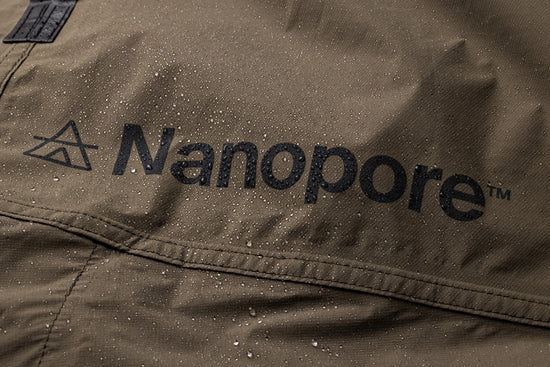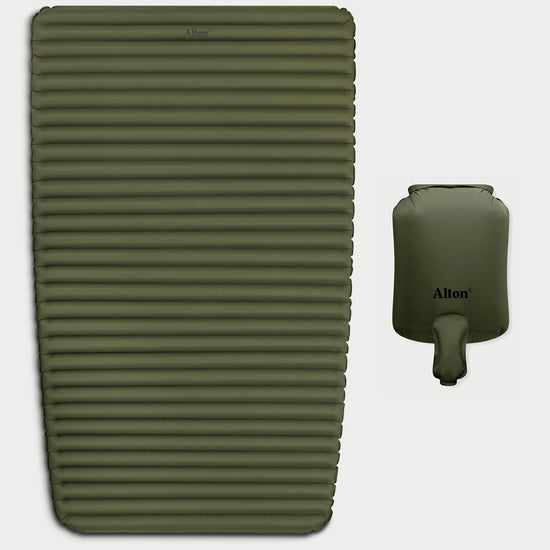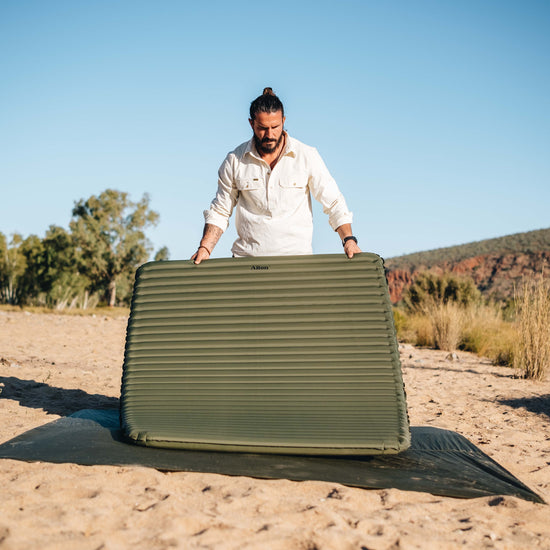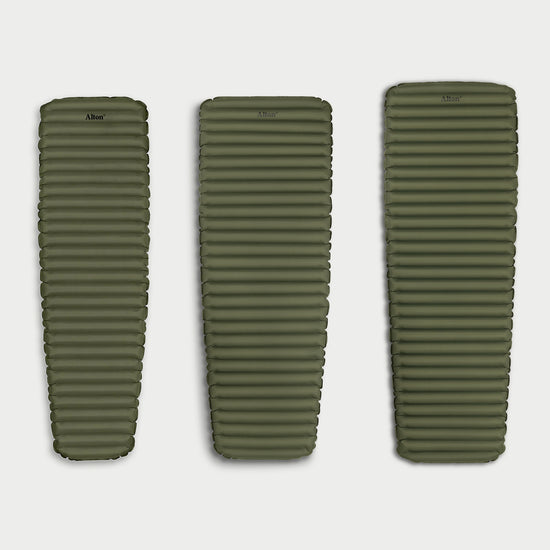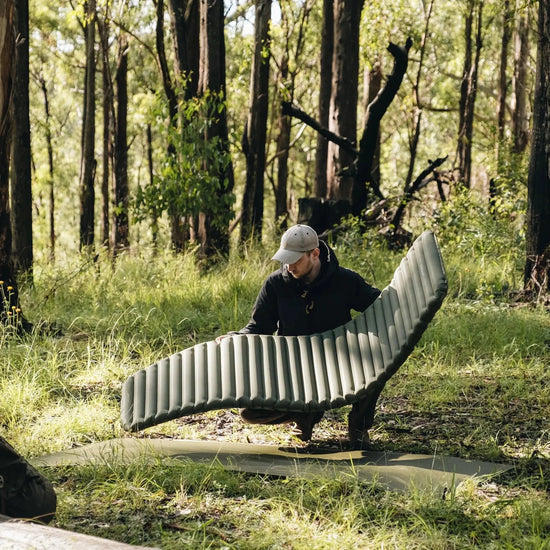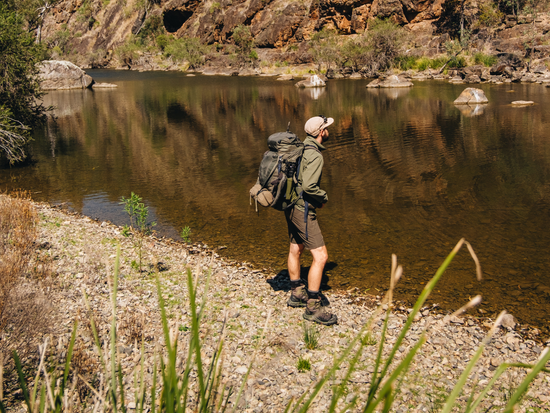We’ve said it before and we'll say it again:
There is no such thing as the ‘best’ sleeping mat – or any piece of gear, for that matter!
Look, if we only cared about profits, we’d say OUR insulated sleeping mats are the best and leave it at that.
But, we won’t.
Our top priority is equipping you with the knowledge to make the decision about which sleeping mat is best for YOU.
Maybe that’s one of our sleeping mats. Or, maybe it’s not.
We’ve got your back, either way.
Yep, radical honesty is just one of the many benefits that come with being an independently owned company, folks.
So if you want to figure out how to choose the best sleeping mat for you, then you’re in the right place.
Are you ready? Let’s do this.
How to Choose a Sleeping Mat for Camping
Warmth & Insulation
The colder it is, the more insulation you’ll need to stay warm. Makes sense, right?
This is where R-value comes in. The higher the R-value a sleeping mat has, the better it will be at preventing heat loss into the ground.
We've covered sleeping mat R-values in detail in, but we'll go over the basics again here. Here are the sleeping pad R-values we recommend for sleeping comfortably different weather conditions:
R-Value 0.5 to 2.0 – Warm conditions with overnight temps of 10ºC or more.
R-Value 2.0 to 3.5 – Cool conditions down to around 5ºC overnight
R-Value 3.5 to 5.0 – Cold conditions down to around -5ºC overnight
R-Value 5.0+ – Extreme conditions with overnight temps below -5ºC
These sleeping mat R-value temperature ratings are comfort ratings.
This means that they provide an estimate for the minimum R-value you need to sleep comfortably in those conditions (assuming you have a good sleeping bag and protective shelter, too).
Remember, a lot of factors go into determining how warm you feel when you're sleeping wild, including your setup and other sleeping gear, wind-chill, and how much you personally feel the cold, so you will need to take these into consideration as well when choosing what sleeping mat R-value is best for you.
To figure out how warm you need your sleeping mat to be, consider these questions:
What weather conditions or seasons do you plan to camp in?
The conditions you will be using the sleeping mat in will determine the necessary R-value for insulation.
Refer back to the suggested R-value chart above to figure out what warmth rating you need, or check out this article for more info.
- Will you be using the mat in winter or higher-altitude conditions?
Extreme conditions, including winter camping, mountaineering and arctic expeditions require specialised equipment. You will need a sleeping mat specifically made for these conditions.
Weight
When choosing a hiking sleeping mat, the ‘ideal weight’ for your needs will come down to what type of activities you will be using it for, and how much you are willing to carry.
To get to the bottom of this, answer these questions:
Will you be carrying your camping gear over long distances?
No? Sweet, you don’t need to worry about the weight of your camping mat.
Weight isn’t so much of an issue for activities where you won’t be physically carrying your gear, such as car camping, 4WDing, rafting and kayaking. It is still practical to choose a lightweight sleeping mat that packs down small, but you can prioritise comfort and durability.
And if you said yes, you are carrying gear over long distances? Weight and packability are going to be much, much more important for you. Every gram counts when you are hiking, biking, pack-rafting or any other adventure where you physically carry your gear for hours at a time or through challenging terrain.
Now, we’re not saying you should rush off to get the lightest camping mat on the market – which is around 200g, FYI. We’re just saying that you should consider the weight of any potential sleeping mat very carefully.
For a standard 1-person camping mat (rated for 2-3 season use), somewhere between 500g to 1kg will be optimal.
How much are you willing to carry?
Some adventurers claim that lighter is ALWAYS better. Others will say that durability is more important than weight. And don’t forget the ‘comfort is king’ camp.
So, what’s our take on this? You do you!
Maybe you are into pushing the limits of your performance. Going harder, faster and further. In that case, it makes sense to go as light as possible, even if it means sacrificing on comfort and durability.
Or, perhaps you are planning an epic adventure that will take weeks or even months to complete. For this, the best sleeping mat will offer both lightweight performance AND rugged durability.
Prefer overnighters or the odd multi-day trip away? Awesome! A lightweight camping mat is certainly still a priority for you – but so is comfort. A few more grams of weight might be worth it to you if it means you get a better night’s sleep.
Only you can decide what you want to carry – or not.

Shape & Size
There's no one-size-fits-all answer to this one (see what we did there?).
Many sleeping mats today come in a variety of sizes, including Regular, Wide, Large and Double, so always check the manufacturer’s size guide to find the best fit.
What about the shape of your sleeping pad?
Sleeping pads come in a range of rectangular, mummy, tapered and semi-rectangular shapes. Let’s take a quick look at each...
Rectangular Mats
Rectangular sleeping mats are a consistent width from head to toe and offer the most sleeping area. This extra space can add to your comfort, but it comes at the cost of more bulk and weight in your pack.
Mummy-Shaped Mats
Mummy-shaped sleeping mats are wider at the shoulder area and taper in towards the feet. These camping mats are designed to maximise your weight savings, but the smaller sleeping area can be uncomfortable for side sleepers.
Semi-Rectangular & Tapered Mats
There is a fair bit of variation within this category, but as a general rule, semi-rectangular and tapered sleeping mats are somewhere between rectangular and mummy shapes. They offer more room than mummy mats while being more space-efficient than rectangular ones.
To determine the best shape and size for your sleeping mat, ask yourself these three questions:
How big are you?
You need a camping mat that fits your body. Crazy, right?
What position do you sleep in?
If you can sleep on your back with minimal wriggling during the night, then you can get by with a smaller surface area to sleep on.
If you sleep on your side or toss and turn a lot during the night, then a wider surface such as a rectangular or slightly tapered shape may be more comfortable for you.
- Is the weight of your sleeping mat your top priority?
If keeping your pack weight to a minimum is your top priority, then consider a mummy or tapered mat, as these shapes offer better weight ‘savings’ compared to rectangular mats.
Durability
Durability is a must if you are a committed adventurer who frequently uses a sleeping mat for camping trips of all kinds. But, durability isn’t measured with a set number or specific rating. Instead, it is a combination of interconnected factors.
The materials, design and construction quality all play a role – but so does how and where you use it. Let’s start from the top:
Materials
You don’t need to be a genius to know that the durability of a sleeping mat is heavily dependent on the materials from which it's made. Camping mats made with high-denier ripstop nylon or polyester offer better durability compared to lighter materials.
Design
The toughest materials in the world won’t make for a durable sleeping mat if the design is flawed. Reinforced seams, durable valves, and puncture-resistant coatings all can improve the long-term performance of your sleeping pad.
Construction Quality
How a camping mat is constructed — the quality of stitching, lamination, and bonding — significantly impacts its longevity. High-quality construction and rigorous quality control measures reduce the likelihood of your sleeping pad failing on you in the wild.

Usage
The more frequently a mat is used, particularly in harsh conditions, the more wear it will experience. Use a groundsheet to protect your sleeping pad from sharp or abrasive surfaces, such as rocks, sticks and sand. Try to be gentle with your sleeping mat when you use it and avoid over-inflating it as this can make it more susceptible to punctures.
Care & Storage
Even the most durable, high-quality camping mat in the world won’t last long if you treat it like trash. To get the most out of your sleeping mat, you need to take care of it properly. Keep it clean and regularly check it over for signs of wear and tear. Store it unrolled and inflated in a cool, dry place away from direct sunlight. For more information on sleeping mat care and storage, check out this blog article next.
Random Chance
Sometimes, durability just comes down to luck. Despite all precautions and care you take with your sleeping mat, all it takes is a random sharp object or unexpected manufacturing defect to burst your bubble (or should we say, sleeping mat?). Check the warranty information of any sleeping mat before you buy it so you know what you’re covered for.
So, how durable does your sleeping mat need to be? Answer these questions:
How do you plan on using your sleeping mat?
Into wild camping adventures or challenging wilderness expeditions? A highly-durable sleeping mat will be essential. On the flip side, for those who only camp in pre-designated campsites or on smooth, flat surfaces, then durability is not quite as vital from a performance perspective.
How frequently will you be using it?
The more you camp, the more wear and tear it will accumulate over time, and the more beneficial it will be to have a durable sleeping mat.
Comfort
Ok, we’ll admit it – we love sleep.
We are all about making our time in nature as impactful as possible, whether that is enjoying the moment, pushing our performance, or sharing quality time with others.
Sleep – and, by extension, a sleeping mat – makes all of that possible.
To understand which sleeping mat will be the most comfortable for you, consider these questions:
What is your preferred sleep position?
Your default sleeping position is going to influence what style sleeping mats you find the most comfortable.
Side sleepers often prefer a thick camping mat that offers support and cushioning for their hips and shoulders. A baffled air-mattress with a micro-adjustable valve will allow you to adjust the firmness until it feels just right.
Back sleepers usually can sleep comfortably on a wide variety of sleeping mats, but should avoid anything too soft, as this can cause back pain. Look for a sleeping pad that offers a balance of support and cushioning.
Like back sleepers, stomach sleepers typically require a thinner, slightly firmer mat to prevent back and neck pain. As a side note, many stomach sleepers prefer a top-quilt over a sleeping bag because it allows them to spread out a little more.
If you wriggle around a lot throughout the night, a wider, longer mat will probably be the most comfortable. All that extra movement makes your sleeping mat more susceptible to damage, so durability will be key for you.
How well do you sleep when you are camping?
Sleep has the power to impact our physical and mental performance, our mood, hunger levels, recovery and more.
If you are one of those lucky individuals who can sleep soundly anywhere and anytime, then you will probably find that you’re comfy on just about anything. But, for most of us camping and sleeping are not a match made in heaven. In fact, ‘poor sleep quality’ is one of the biggest reasons that people decide they don’t like camping!
Fortunately, your sleeping mat can make a huge difference to your sleep quality. Once you know your sleeping position and preferences, start looking for camping mats that tick all the boxes on everything we’ve covered in this blog so far.
While you are at it, we have a whole blog on how to improve your sleep, so be sure to check it out after this.

Price
It's time to talk about money. Among sleeping mats, there is something we like to call the ‘GLC Triangle’. GLC stands for Good, Light and Cheap.
‘Good’ relates to the quality of the sleeping mat, which impacts both the durability and comfort it will provide.
‘Light’ is a catchall term for weight AND bulk.
‘Cheap’ is pretty obvious, right?
Here’s how the GLC Triangle works:
You can get a light sleeping mat that is cheap but it probably won’t be very good.
You can get a good sleeping mat that is crazy light, but get ready to pay for it because it won’t be cheap.
And, you can find a good sleeping mat that is relatively cheap, but it won’t necessarily be light.
When it comes to the price of your sleeping mat, ask yourself these questions:
Do you want a quick-fix or a long-term solution?
It can be more expensive up front, but a good, high-quality camping mat will last longer, be more comfortable and perform better than cheaply-made alternatives.
Many committed adventurers prefer to invest in a high-quality sleeping mat that will last for years to come, even if that means paying more up-front.
However, if you are new to camping or just ‘not that into it’, then you may not see the value in a high-quality, durable sleeping mat that will last for years.
In this case, consider buying a second-hand mat or even borrowing or renting one before buying your own.
What is your budget?
You can get a camping mat for under $50, all the way up to over $500.
While price and quality are closely linked, you can definitely find a great sleeping mat that will meet all your needs on the lower end of the price range.
For example, if you decide that your budget is under $100, shop around to look at your options. You might score a deal on sale, or find something second-hand. Or, although they are considered a bit old-school now, closed-cell foam pads are generally cheap, highly durable and ultralight – albeit very bulky.
Even if you are not limited by any budget constraints, it is still worthwhile being selective about what you buy – the most expensive option is not necessarily going to be the best for your individual needs.
Which sleeping mat will you choose?
If you have made it all the way to this point, then you should have a clear picture of your ideal sleeping pad.
You know the specific R-value, weight, shape and size that you need.
You know how durable your camping mat needs to be, and what features will offer you the most comfort based on your preferences. And, just as importantly, you have a price range in mind that fits your budget.
Now, all that is left to do is get out there and find the BEST camping mat for you.



